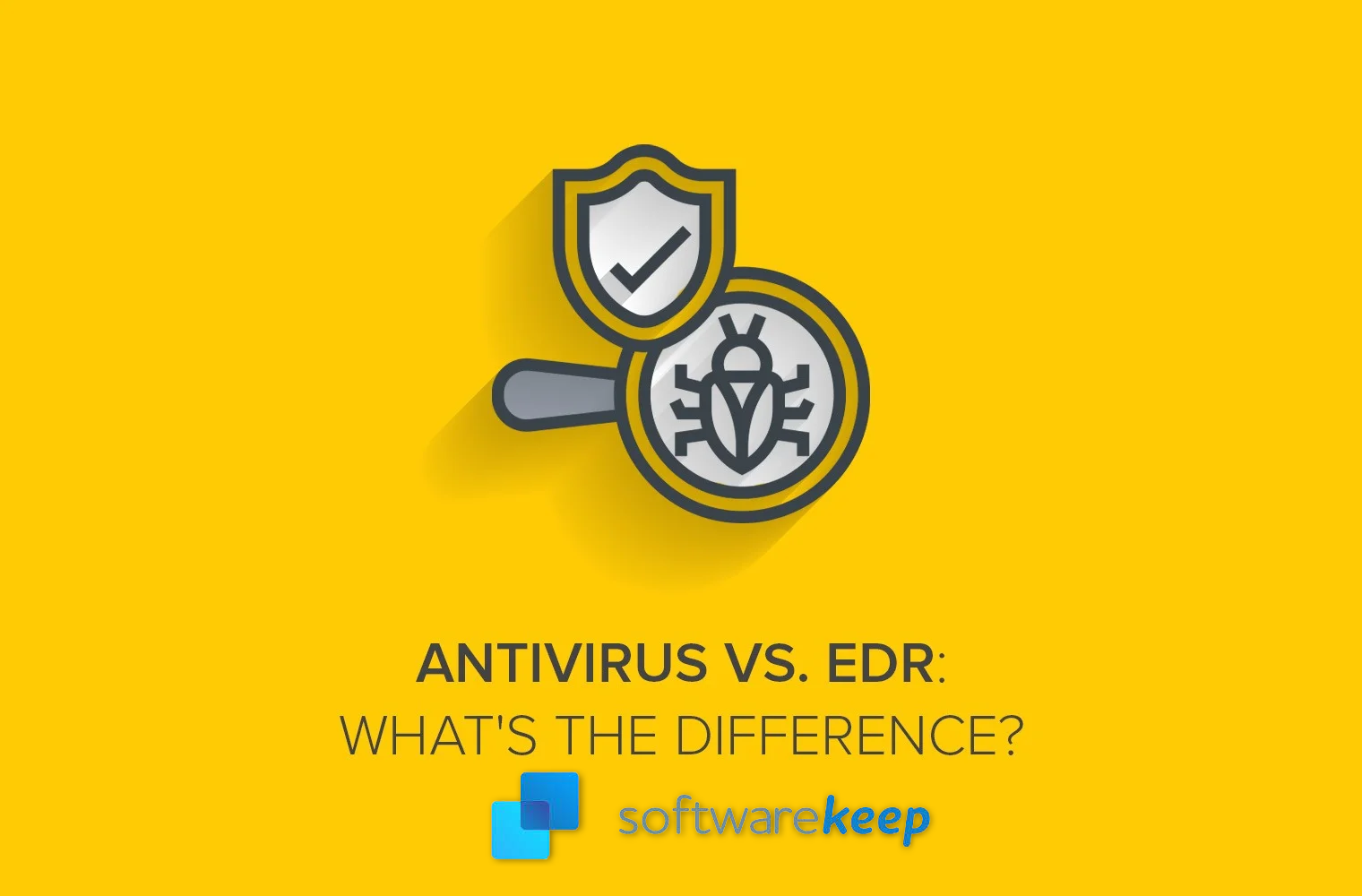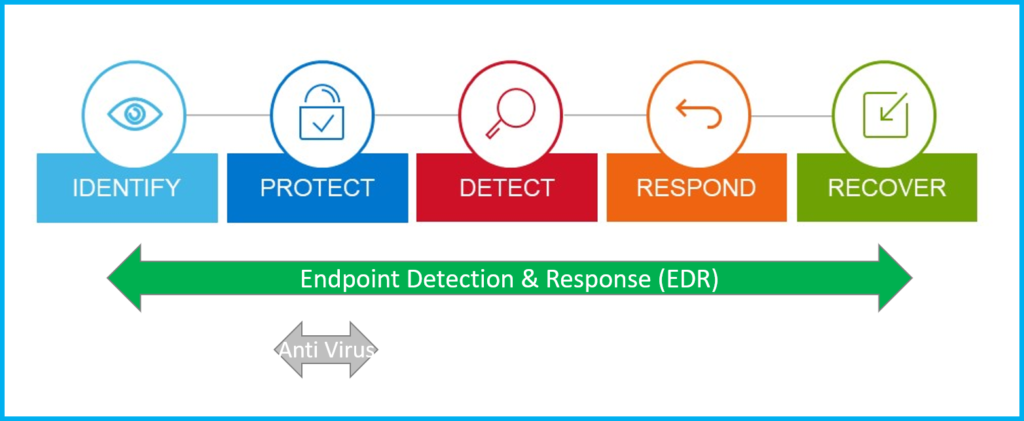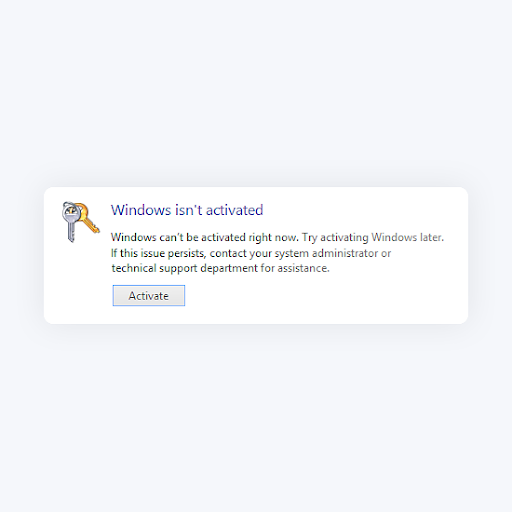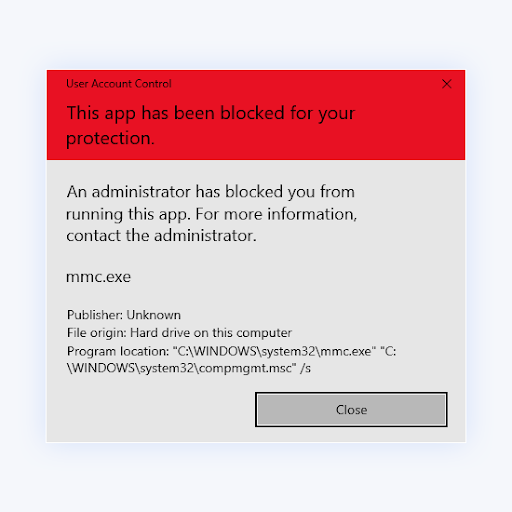Traditional Antivirus vs. EDR: EDR Antivirus Difference

Traditional Antivirus vs. EDR (Endpoint Detection and Response) cybersecurity solutions
Antivirus software has been a staple in the business world for many years. However, with the increase in threats and cyber attacks, more and more businesses are turning to endpoint detection and response (EDR) software as their primary line of defense. Why?
EDR solutions have many advantages and capabilities that traditional antivirus programs or legacy AV do not offer.
So, what is the difference between traditional antivirus tools and EDR? How do I distinguish between antivirus solutions and EDR? And which one should your business be using?
In this blog, we take a look at the difference between antivirus solutions vs. EDR cybersecurity solutions, the benefits of EDR solutions, and the areas where EDR tools score over traditional antivirus.
What is antivirus program?

An antivirus program is a software installed on a computer or server to protect it from malware. AV programs work by scanning identified threats like incoming files and emails for signs of malware, and then quarantining or deleting the infected files. AV programs can also be set to scan the entire system regularly for any new infections.
How do Legacy antivirus solutions work:
-
Scan files and uses signature-based detection recognizes only known threats.
-
Can include scheduled or regular threat hunting or scanning of protected devices to detect known threats
-
Effective in the removal of basic viruses (worms, trojans, malware, adware, spyware, etc.)
-
Legacy antivirus programs provide warnings about possibly malicious sites
What is EDR and What does it do?
First, what’s an endpoint?
Endpoints include mobile devices, laptops, workstations, servers, and any entry point to a IT network. Almost anything connected to an organization’s network should be considered an endpoint.
Having multiple endpoints is a security risk for organizations. Working from anywhere or using multiple devices for entry means adding endpoints of access, which results in more ways attackers can find their way into an organization's IT network, and more opportunities for breaches and data loss. But because this is unavoidable, increasing endpoint protection and security is important.
As an organization's endpoints increase, it becomes necessary to take more advanced steps to protect the devices and users. This is where endpoint protection is needed and where EDR comes in.
An EDR security system is a type of security software that provides visibility and control over the devices on a network to identify and arrest cyber threats.

EDR solutions work by continuously monitoring the activity on each computer endpoint and then flagging any suspicious behavior also known as proving endpoint security. This includes protecting the computer or server against advanced threats.
EDR solutions also provide the ability to quickly contain and remediate any discovered malware infections and active threats.
How EDR Works

EDR systems work in the following ways:
- Install EDR agent
- Behavioral analysis to connect activities
- Detect and report malicious activity
- EDR algorithms identify breached end points
- EDR processes data points into narrow categories
- Analysts review alters and information
In summary, EDR security systems can do the following:
-
EDR includes real-time monitoring and detecting threats, including unknown and emerging threats, malicious behavior, and those not easily recognized or defined by traditional antivirus solutions.
-
EDR is based on behavioral analysis to identify malware and detect unknown threats.
-
Data collection and analysis determines threat patterns and alerts organizations
-
Forensic capabilities can assist in determining what has happened during a security event
-
EDR systems detect, isolate and quarantine suspicious or infected items using sandboxing to ensure a file’s safety without disrupting the user’s system.
-
EDR can include automated remediation or expulsion of certain network, cyber, and environment threats.
- EDRs are better analytical tools
EDR vs. Antivirus solutions Differences
There's a slight overlap between the functions of EDR solutions and antivirus solutions or legacy AV programs.

The biggest difference between antivirus and EDR is that EDR provides continuous monitoring of activity on each endpoint, while AV solutions only scan for malware when a new file or email is received. This means that EDR can detect cyber threats and malicious activity even if the malware has not been seen before, whereas AV programs can only detect known malware signatures.
Another key difference is that an EDR solution provides the ability to quickly contain and remediate any discovered malware infections. On the other hand, an antivirus can only quarantine or delete infected files. This is a critical difference because with EDR solutions businesses can quickly get rid of any malware or unknown threats that have managed to sneak past the antivirus software.

In summary, the key differences between EDRs and antivirus tools are:
-
EDR solutions are behavior-based. This means they recognize even unknown and modern threats. Antivirus is largely signature-based, so it only recognizes malware that is known to the system when handling cyber threats.
-
Data collection and analysis happen in real-time with EDR through artificial intelligence. This provides security teams with a more comprehensive understanding of system health and endpoint protection. On the contrary, many antivirus software schedule screenings instead.
-
EDR has advanced forensic capabilities for threat detection compared to AV protection, supported by artificial intelligence.
-
EDR employs automated responses – like endpoint isolation – to investigate potential threats and protect the whole system before an attack grows out of control. Antivirus only gets into action after a threat has crept into the system.
These are the reasons why EDRs are today's preferred technology in combating old and new threats, as well as stop attacks and protect all endpoints in an organization's IT network.
Antivirus vs. EDR: Which is best for your needs
The answer to this question depends on the specific needs of your business. If you are only concerned with protecting your computer or server from known malware, then an antivirus program may be all you need. But if you want to have the best possible protection against all types of cyber issues, including advanced threats, then an EDR solution is a better enterprise endpoint security solution.
To protect your organization’s sensitive information from bad actors, you likely need both antivirus and EDR security tools as part of your enterprise security strategy. In fact, many EDR solutions come with a traditional antivirus solution component baked in as an extra security measure.
In the long run, combining the two solutions under one solution – such as a Managed Detection & Response solution – is best and provides an advanced security strategy for your enterprise. You can use a central database to identify each system's effectiveness.
Benefits of EDR solutions
Today, because of the ever expanding digital networks, EDR systems have become a must-have for all enterprises. Modern EDR systems protect businesses' digital perimeter from evolving enterprise security threats and cyber issues.
The key benefits of using an EDR system in an organization are:
Comprehensive protection
EDR solutions use machine learning to collect comprehensive and high quality forensic data on malicious processes, polymorphic malware, potential attacks. They continuously monitor all the endpoints of a network's digital perimeter both online and offline. The system collects comprehensive data that facilitate investigations and incident response resulting in advanced protection.
The data is collected and stored on the endpoints for threats detection. They give security analysts in-depth insight and understanding of anomalies and vulnerabilities of a network to help them prepare better strategies to protect enterprises from cyber actors.
Detection of all Endpoint Threats
One of the biggest benefits of using EDR security systems is their ability to detect all endpoint threats through machine learning. It gives security teams visibility on all the business's digital perimeter endpoints. This is why they're superior to the traditional anti-virus solutions or other tools in providing adequate security and additional protection. EDR can help IT teams better understand the nature of attacks and prepare appropriate responses.
Provides Real-Time Response
EDR solutions provide real-time responses on running processes to different potential threats. An analyst can see the potential attacks and threats as they evolve in the network and monitor it in real-time. This is very useful and can cut off the attack in its initial stages before it becomes critical for the network. An EDR solution collects data on suspicious and unauthorized activities on the network and can get to the threat's root cause, thereby enabling a better response. This is is better than the signature based response from traditional antivirus programs.
Compatibility and Integration
EDR systems are today highly advanced, compatible, and better integrated with other security tools. This integrated approach provides a decentralized security system that better protects networks from potential cyber threats and attacks. It allows analysts to correlate data pertaining to network and endpoint security. This enables them to develop a better understanding of the techniques and behaviors that cybercriminals use to hack into networks and systems.
Final Thoughts
EDRs can proactively address security and threats after they have penetrated an organization's endpoints, but before they cause damage. Antivirus software only protects the system after threats access and begin causing damage.
That's it about traditional antivirus tools and endpoint protection platforms. Now we'd like to turn it to you.
Follow our Blog for more great articles like this one! In addition, you can check our Help Center for a wealth of information on how to troubleshoot various issues. Also, Sign up for our newsletter to get promotions, deals, and discounts from us right in your inbox.
You May Also like
> How to Set Up Security in Windows 10
> How to Protect Your Data Online - What You Need To Know
> How To Fix the “This PC Can’t Run Windows 11” Error
> How to Enable Remote Desktop On Windows
Antivirus vs. EDR FAQ
Is EDR the same as antivirus?
EDR not only includes legacy antivirus solutions and protection but also contains many security tools like firewalls, whitelisting tools, monitoring tools, etc. to provide comprehensive protection against digital threats.
Is EDR better than antivirus protection?
The EDR system detects all endpoint threats and responds immediately. EDR Systems also collects quality forensic data necessary to respond to an incident or investigation. Furthermore, EDR security software is more capable of handling cyber attacks better compared to traditional antivirus software.
What is EDR in antivirus?
A comprehensive End Point Security System (ENDS) that combines real-time continuous monitoring and collection of endpoint data to automate automated response and analysis.
Do you need EDR and antivirus?
No. Although they're both important when evaluating EDR vs. antivirus, EDRs do all the best AV solutions do – and more. If your antivirus software fails, consider EDR technology.
Can EDR replace antivirus?
Is EDR a replacement for antivirus? You can use EDR solutions to track, monitor, and analyze endpoint data to further fortify an environment. Generally, EDR systems do not replace traditional tools like antivirus and firewalls; they work beside them to provide enhanced security capabilities.
Is endpoint protection the same as EDR?
Endpoint Protection Platforms (EPPs), are protection software solutions designed to detect and prevent threats - known, unknown, or fileless malware on a network or endpoint devices. EDR solutions are tools for detecting or handling incidents that manage to bypass your EPP or other security measures.
What is EDR and how does it work?
Endpoint Detection and Response (EDR) is a security solution for Endpoints that continuously monitors end-user devices to detect and respond to cyberthreats and malicious malware.
What are EDR tools?
EDR programs are a class of technologies used to identify or investigate a threat on an endpoint. EDR software usually offers detection, investigation, threat hunt, and response capability. An endpoint can be an employee workstation or laptop, a server, a cloud system, a mobile or IoT device.
What does EDR stand for?
The endpoint detection and response (EDR) system combines computer data and endpoints to analyze threat-related information to identify computer systems' vulnerabilities and facilitate an effective and efficient response.
What is EDR example?
Some of the notable endpoint protection tools include EDR, Fire Eye, Symantec, RSA, CrowdStrike, Cybereason, and Cynet Security platform.










